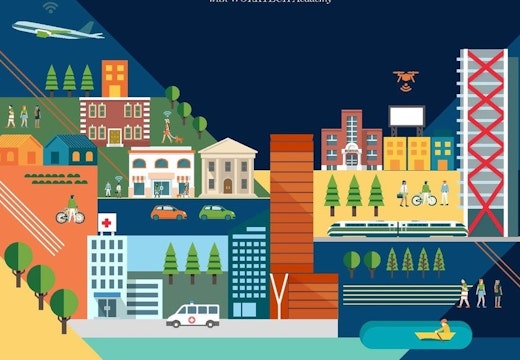Real-time real estate: from smart buildings to smart precincts
Integrating physical experiences with smart services and building intelligence in the smart building is now being extended to entire smart precincts, known as digital districts
The modern smart office building utilises a range of technologies to reduce energy costs, utilise space more efficiently, create an enhanced user experience and underpin corporate culture and values. Companies achieve all this by tracking occupation, movement and resources in real time and adapting their systems accordingly to optimise the performance of both the building and the people within it.
The workplace industry has a term to describe the approach – ‘real-time real estate’. Just as retail managers can digitally track the movement of customers and the purchase of goods – adjusting light levels, opening aisles and activating checkout points in immediate response to what is happening in the store – so building managers have the real-time capabilities to adapt and reconfigure the workplace to support such objectives as wellbeing, innovation and productivity.
Three waves of progress
How did the tools and technologies of real-time real estate emerge? One can chart technological progress in three waves. The first wave of change from 1996 to 2006 saw the basic foundations of the smart building: the rapid growth of the commercial Internet, the proliferation of personal devices such as laptops and mobile phones, the advance of building management systems and the standardisation and roll out of both high-speed cable and wireless networks all contributed to the early momentum.
The second evolution from 2006 to 2016 built on these developments with more sophisticated devices, like smartphones, and faster connectivity. Technology convergence, open source software, workplace apps and cloud computing further changed the game and brought the full potential of the smart building out into the open.
Now we are well advanced in the third wave of the smart building – this is the era of the ‘digital ecosystem’ and it is being propelled by billions of connected devices and sensors, faster and more widespread connectivity as well as the rise of AI and it’s ability to leverage huge volumes of data.
Smart precinct of the future
But it would be a mistake, however, to think that the impact of real-time real estate on the workplace manifests itself only inside the single office building. Experts acknowledge that the opportunities extend to entire smart precincts – extended city blocks or urban districts that mix workspace with retail, residential, education, leisure and transport hubs, and bring real-time real estate into play across the complete mixed-use estate by integrating physical experiences with data-driven services and smart technologies.
These ‘digital districts’ build on prior experience in designing for creative clusters and mixed-use developments, but they go a stage further in using building intelligence, smart services and big data to mix together a mutually reinforcing set of property offers in one urban quarter. An approach which could support efforts to bring foot traffic back to empty central business districts.
Research by WORKTECH Academy with Australian developer Mirvac identified four core typologies of the smart precinct:
Enterprise model (workspace-led): this model is built around the idea of a dynamic workspace campus dominating a large part of the district. The main accent: business innovation, acceleration, and incubation.
Emporium Model (retail-led): This model is built around the idea of a lively shopping center dominating a large part of the district. The main accent: smart retail destination.
Haven model (residential-led): This model is built around the idea of prime residential accommodation occupying a sizeable share of the district. The main accent: the smart home quarter.
The interchange model (transport-led): This model is built around the idea of a transport interchange taking centre stage in the district. The main accent: the smart mobility hub.
Read more on From Smart Buildings to Smart Precincts here.








